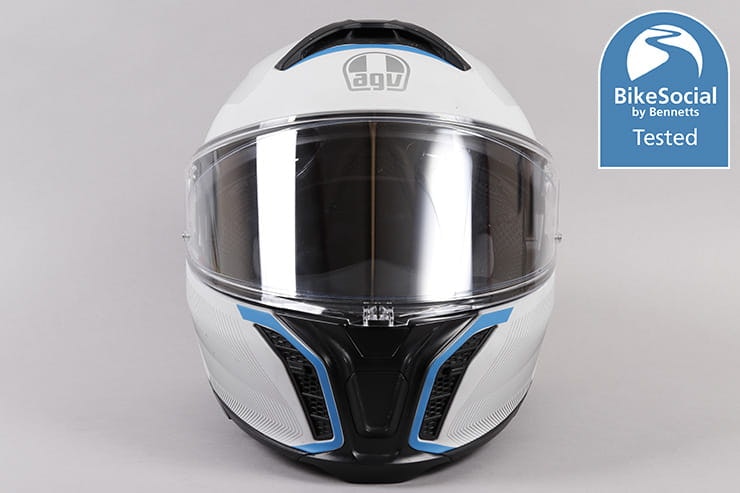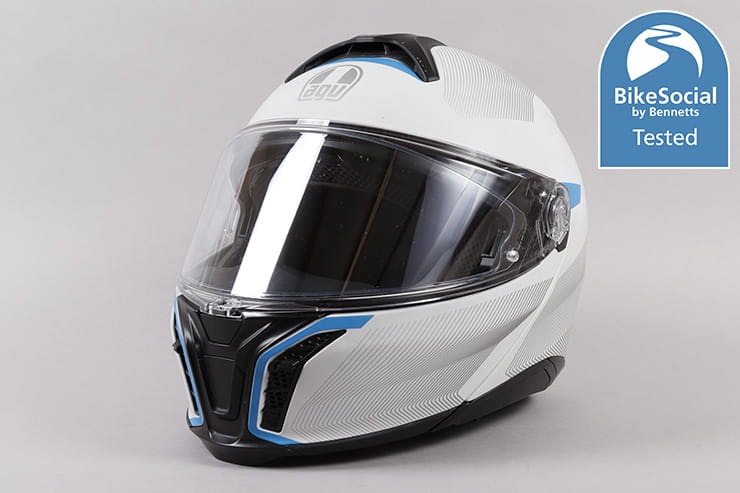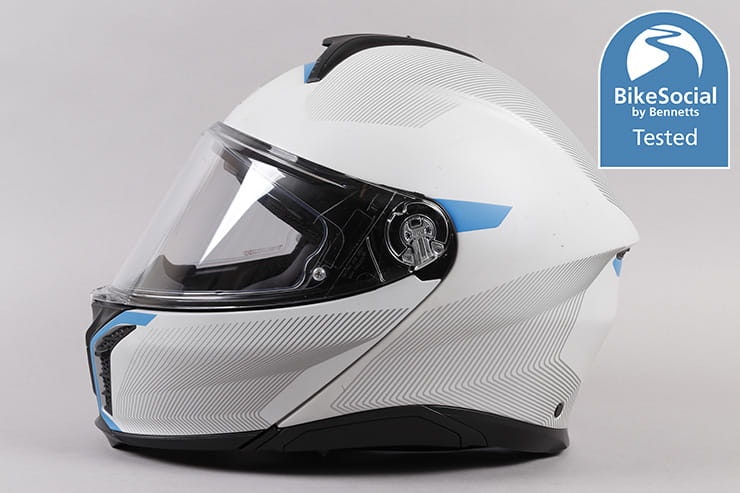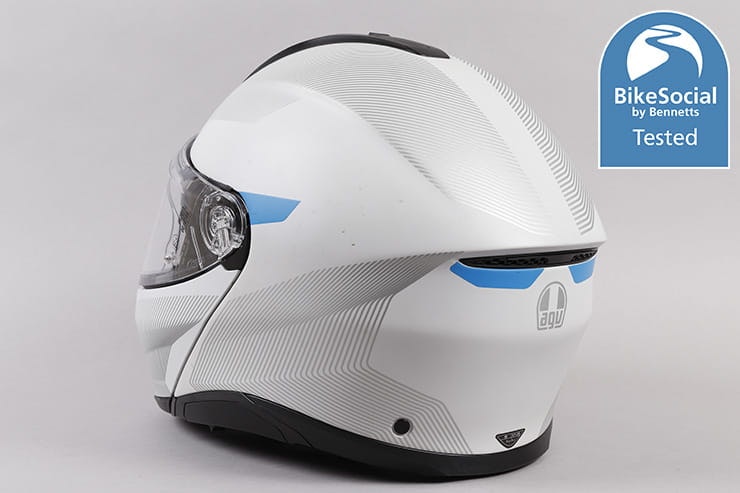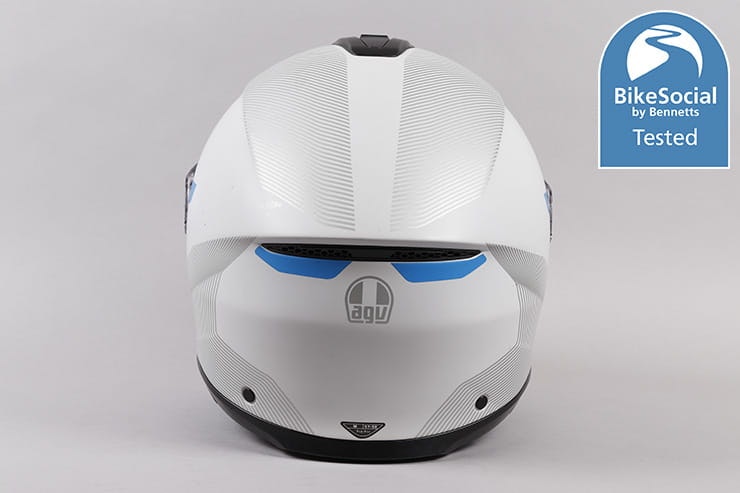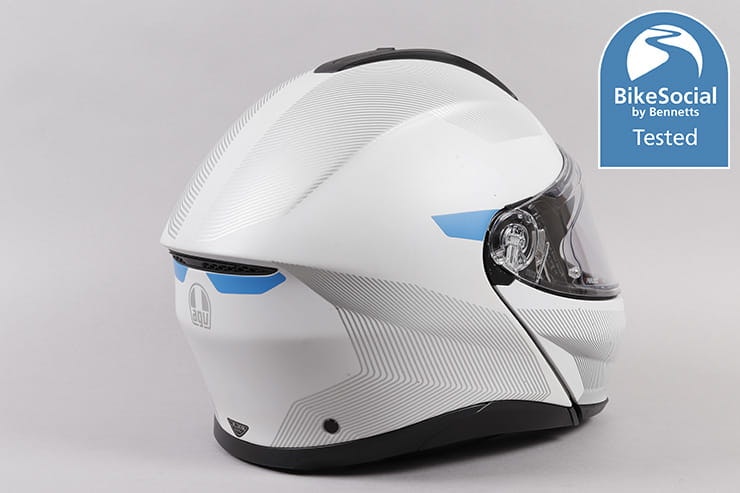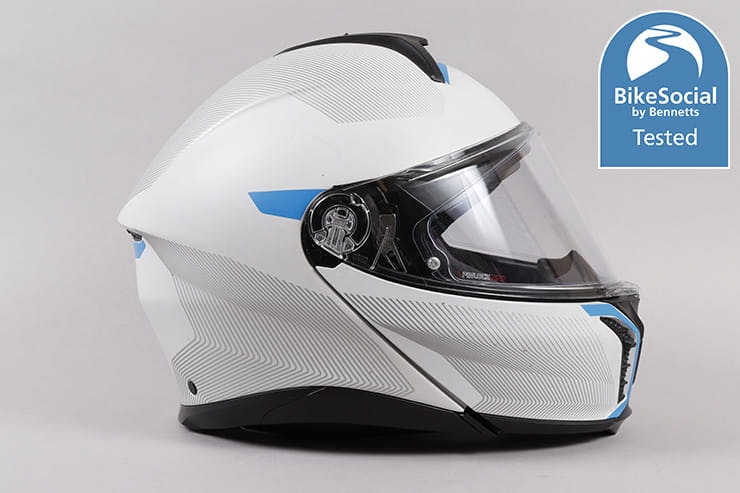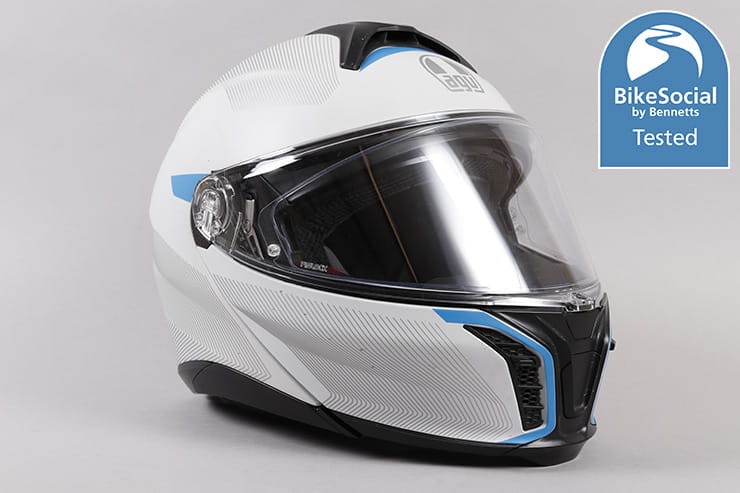AGV Tourmodular review | ECE 22.06 flip-front modular helmet tested
By John Milbank
Consumer Editor of Bennetts BikeSocial
24.01.2023
Date reviewed: January 2023 | Tested by: John Milbank | RRP: From £449.99 | www.agv.co.uk
The AGV Tourmodular on test here is one of the first ECE 22.06-certified flip-front (or modular) motorcycle helmets on the market, alongside the Schuberth C5 reviewed recently.
This new test standard will be required on all lids made from July 2023, meaning you might see some discounted stock of ECE 22.05 helmets being cleared in the coming months. They’ll remain legal to wear of course, and there’s the possibility of the sale of them being stopped at some point, but for now at least, expect to see stocks of 22.05 lids dwindling, with new helmets meeting the higher standard becoming much more prevalent.
ECE 22.06 is a much tougher test standard, with more impact points on the helmet, higher forces involved and an ‘oblique’ test, which creates a maximum level of rotational force transmitted to the brain in a crash.
Personally speaking, if I were to recommend anything to someone looking to buy a new motorcycle helmet, it’d be to get one that’s certified to ECE 22.06, as it provably has the potential to offer better protection.
I’ve been wearing the Tourmodular for several months on a BMW R1250GS and Honda VFR800 to find out if it’s any good…
Superb chin bar fastening
Great ‘just-open’ settings on visor
Excellent coverage from drop-down sunshield
Fitting aftermarket comms is tricky
Visor latch takes some practice
Visor aperture shallower than some
Outer shell
The AGV Tourmodular has a carbon/aramid/fibreglass main shall with a plastic chin section (this is the case on most flip-front). It comes in three shell sizes across the XS to XXL fittings, so someone with a small head won’t have to put up with an overly-large outer shell.
Retail prices start at £449.99 for matt or gloss black, rising to £499.99 for colours and £529.99 for graphics, like the ‘Frequency’ scheme I have here.
The matt paint is very good and the plastics tough, if not having something of the most premium-looking finish to some of them. When I first put lid on and pulled the cheeks apart to slide over my head, there was a worrying crack sound. However, looking inside I found that the EPS panels are cleverly separated, and it was just a sticker that bridged two of them being pulled off.
The chin bar mechanism is outstanding – probably one of the best I’ve used. In some modular helmets I’ve found that the chin bar needs an extra push to ensure it locks down securely, in some extreme cases needing a squeeze on both sides. But on the Tourmodular it’s striking just how easily and cleanly this closes. Pull it down and a swift snap indicates it’s safely locked.
I thought it might be down to my head shape, but when explaining to another journalist how good I thought it was, they tried one on too and were impressed with just how well it worked.
As is now the requirement of all ECE 22.06 flip-front helmets, the Tourmodular is homologated as P and J, meaning it can be ridden in with the chin bar open or closed. There’s a metal lock lever on the right of the lid, but it’s very fiddly to use with the helmet on, to the point of being pretty much impossible to operate with gloves. This feature isn’t necessary for normal riding though, as the chin section stays open without any issues.
Weight
Claimed weight of the smallest shell size is 1,620g. My medium showed 1,703g on my scales, which puts it in the same ballpark as the Schuberth C5, C4 Pro and the Shoei Neotec II.
People tend to get hung up about the weight of helmets, but I’ve yet to find one that’s truly ‘heavy’ when being worn.
It can be a great selling point by dealers to let you compare two in the hands, or to even try to steer you with the way they hand you them, but what really matters is wind drag, and I’ve had no problems with the AGV Tourmodular, either direct into the wind or when turning my head for a life-saver.
Of course, wear it with the chin bar open and you’ll feel significant drag as it acts like a sail, but that should come as no surprise.
Ventilation
The AGV Tourmodular comes with a removable chin skirt than snaps easily and securely into place to create a more still environment inside the lid. On my 2001 Honda VFR800 I still noticed a small amount of air movement around my chin, though this will depend very much on your face shape. Removing the chin skirt makes for a more airy feeling, better suited to the summer. On the VFR, which sees the wind more easily reach the bottom of the lid than on the GS, for example, this created a more drafty feeling across the face with the vents shut.
The exhaust vent is always open, which is fed by four holes and channels spaced across the upper rear of the expanded polystyrene liner. These channels start at the three holes that come from the top vent scoop, which – despite the relatively small slider button – is fairly easy to operate with winter gloves on.
The chin has a standard press-operated central vent that blows across the inside of the visor, with two separate sliders that open and close apertures feeding direct to the mouth.
Air seems to move well through the lid, though the top-vent creates a little bit of a draft ‘hot spot’. The chin vent doesn’t create any noticeable draft across the forehead, while opening the mouth vents gives a very useful blast of air, depending on the shape of the screen you’re sat behind. There’s a mesh behind these vents, which helps prevent flies getting through. The plastic grille is dense enough to prevent large bugs getting in, though if the mesh inside does fill up with grime and midges, there’s no obvious way to get inside for cleaning.
The effectiveness of any helmet’s ventilation will always depend on the screen and fairing of your bike, but one of the many advantages of a flip-front is that you can always pop it open if you want to ride with it as an open-face.
Visor
A Pinlock Max Vision 120 is supplied, which is the top-of-the-line anti-fog insert. Being ‘Max Vision’ it also covers most of the visor, so doesn’t interfere with your view.
AGVs often have a slightly shallower visor aperture than some other brands, especially at the sides, and this is most noticeable when looking to the left or right, especially during a life-saving shoulder-check. It’s not a problem, but when switching from other brands you might notice it.
You might also notice that the chin bar sits a little higher than on some, but overall vision is very good.
I have found that the visor can rattle if it’s open and caught in buffeting wind, and as with the Sportmodular, the black locking clip on the bottom of the visor can be annoying to see when you’re riding with it open – the visor doesn't open that high, so this could be an issue worth checking. I've also found that over time the visor has become more loose, resulting in it not staying open at speed.
The visor operates on a smooth three-stage ratchet that also has a locked but just-open setting, and another cracked-open position above this, making for plenty of extra ventilation if you want it. The visor lock needs a careful swipe with a gloved thumb to release, and while it’s something that frustrated me in the previous Sportmodular, perseverance does pay off. Though still, any panicked fumble while holding the clutch at the traffic lights can make this less easy to flick open than the likes of the Neotec II and C5. Still, the pressure required to open the catch is adjustable by unscrewing the black clip on the visor and sliding it backwards or forwards.
As long as you haven’t bitten your finger nails down to the quick, the visor’s easy to remove and replace – just pull the tab down on either side to lift it clear and when popping it back on.
The visor seals very well even in torrential rain. Opening it up after a storm does see some collected water drip down, but it’s nothing that’s a problem.
This part broke, but it was easily replaced and dealers haven’t seen issues with others
While photographing the AGV for this review, I noticed that one of the small cast metal lugs inside the visor mechanism had broken. The visor was still holding in place, but it wasn’t tight against the side of the shell.
Fortunately this is a replaceable part, and Motodirect – the UK distributor of AGV – quickly sent out a replacement part, along with clear directions of how to fit it. This was a very simple change, though if you were in any doubt, your dealer would be able to help.
I spoke to some large UK motorcycle clothing stores, who told me that they haven’t seen any other breakages like this, so I’m confident that this would be an unlikely problem to come across. Still, it’s good to know that the UK supplier doesn’t hesitate to help if there is an issue.
The Tourmodular has a drop-down sunshield fitted, which is operated by a lever on the left of the shell’s skirt. I find this comes down far enough to eliminate the bright line of sunshine that’s usually left beneath it in most other helmets, while only just touching the tip of my nose; impressive.
Lining
Unlike the Sportmodular, the AGV Tourmodular’s lining is not reversible for hot and cold weather. To be honest though, I didn’t tend to bother with that, and this lining – which is easily and fully removable for cleaning – feels comfortable and very well made.
Fastening
The tour modular uses a micrometric ratchet system that’s ideal for a touring helmet as it’s quick and easy to use, even with gloves on.
Interestingly, the chin strap also has anti-roll-off retaining straps running to the rear of the shell. This is something that Schuberth highlights on its helmets, and is designed to reduce the chance of the lid being pulled up and over the head from the rear in an impact.
Fit
Fit is of course extremely subjective, so it’s vitally important that you try any helmet – regardless of whether you’ve had that brand or even model before – before you commit to buying.
AGVs have been a little hit and miss for me, but the AGV Tourmodular felt very good from the off, with no pressure points on the head, despite fitting snugly. I did however notice undue pressure around the rear of my jaw after about an hour, which was quite uncomfortable during the first few rides.
I found that by pulling the helmet down a little firmer at first, the pressure on my jaw was eased, and while it made me think it perhaps wasn’t the perfect shape for my head, it now seems to have settled in a lot better. Remember, fit is very personal so you must check for yourself.
I wear glasses, and they fit fine in the Tourmodular, the arms tucking easily behind my ears and the bridge sitting correctly on my nose.
The Sportmodular sat very close to my face, particularly at the chin, but the new Tourmodular is a lot more accommodating. If you found the Sportmodular to be somewhat claustrophobic, you’ll be pleasantly surprised at the new model.
The neck skirts help seal well, though do check the fit
Noise
All helmets require the use of earplugs above about 40mph on most bikes, but it’s the fairing and screen that causes most of the buffeting.
I was aware of the wind noise at high speeds on the VFR800, and the engine note on the GS, but there’s nothing particularly outstanding – good or bad – about the noise levels in the AGV Tourmodular.
For more information on why earplugs are vital with any helmet, and advice on which are the best, click here.
Can you fit your own intercom to the AGV Tourmodular?
This is my main frustration with the Tourmodular – the difficulty in fitting aftermarket comms.
Most brands are now going down the route of encouraging buyers to use the intercom systems designed for the lids, and AGV has its ‘Insyde’, which retails at £344.99 and is made by Cardo. This promises to be a top-end system that incorporates both Bluetooth and Mesh. You can read our reviews of intercoms here, but if you haven’t tried it yet, Mesh is a newer technology that makes connecting multiple intercoms a LOT easier than with Bluetooth. However, it’s important to note that it’s not cross-brand compatible, so while some manufacturers have teamed up for future release compatibility, the two main players – Cardo and Sena – refuse to play nicely together, so if your mate has a Shoei with an OEM Sena-made device, for instance, you won’t be able to connect the two using Mesh. Bluetooth should work, but I’ve never found it an easy process.
I’ll update this review if I get a chance to try the Insyde, and well as completing a full stand-alone test of it.
I’m in the process of reviewing the new Sena Spider, so figured I’d fit that to the AGV. It’s possible, and I was able to tuck everything out of the way and get the unit stuck securely to the side of the lid, but the fact that AGV has chosen to put the channels for the microphone arm on the opposite side internally means that it’s really tricky. Intercoms tend to have a short cable to the mic, so you’re forced to put it on the same side as the control unit is mounted. Combined with the rail-mounts of the cheek pads, this was the trickiest lid I’ve found to fit an aftermarket, non-standard intercom to. It's doable, but worth noting if you have your own device that you want to use.
Three alternatives to the AGV Tourmodular flip-front helmet
Flip-front helmets are great for letting some air in, for rarely having to remove them when filling up with fuel, for chatting with mates and for asking directions. There are plenty of options, but not many that are certified to the tougher ECE 22.06 standard…
The Schuberth C5 was the first flip-front to meet ECE 22.06, and it’s a very good lid. I was extremely impressed at first, though after several months of use the visor become more loose and now won’t stay open at speed, and – more worryingly – extremely cold and wet conditions can overwhelm the Pinlock due to an apparent lack of ventilation in the visor aperture. There have also been reports of the chin vent falling off and taking a long time to be replaced, though I haven’t experienced this. The full review is here.
The Shoei Neotec II is for many the benchmark modular motorcycle helmet, but it’s yet to be updated to ECE 22.06. We’ve no idea what – if anything – will need to be changed, but we’re expecting an announcement in 2023. You can read the review of the ECE 22.05 model here.
If you’ll be regularly riding with the chin bar open, consider either the LS2 Valiant II reviewed here (we haven’t tested the 22.06-approved Advant yet), or the Shark Evo GT reviewed here as both have a chin bar that flips all the way to the rear of the lid.
These are just three of many alternatives – you can find all the helmets we’ve tested here and be sure to regularly check for the discounts available through Bikesocial membership.
The locking mechanism is excellent on the AGV Tourmodular
AGV Tourmodular review: Verdict
I was disappointed with the Sportmodular, and while the Tourmodular hasn’t addressed all my gripes, it does come together to make for a much more accomplished design.
Fit is what matters the most, but if you’re looking for the potentially safer ECE 22.06 flip-fronts, your choices are limited. We’ll be reviewing as many as we can over the coming months, but in January 2023, the main competition is the Schuberth C5. That’s a very accomplished helmet, but time has revealed some flaws that do need addressing.
Overall, thanks to its excellent chin bar locking mechanism, improved fit, sunshield coverage, visor control and customer support, the AGV Tourmodular is a great flip-front helmet that’s well worth considering.
